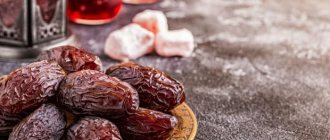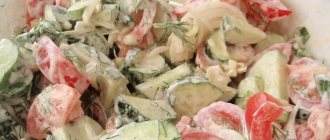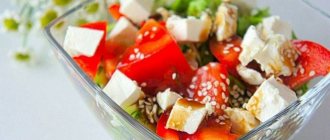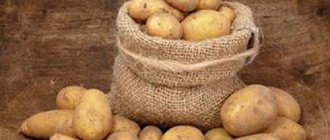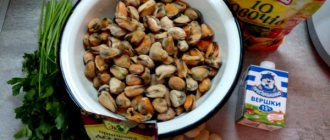Chickpeas (lamb or chickpeas) are a legume plant that is common in Australia, America, Africa and Asia. Currently, it can be bought in almost any store. Chickpeas are yellow, green or brown beans shaped like a lamb's head with a pointed nose. The nutritious product is used to prepare first and second courses, as well as the famous hummus. Eating chickpeas should be done with caution, as they cause increased gas formation.
- Hummus
Nutritional and energy value
Energy value per 100 grams of chickpeas depending on the cooking method (kcal):
- Raw - 317.
- Boiled - 170.
- Fried - 520.
- Sprouted - 158.05.
Nutritional value of chickpeas (BJU ratio) per 100 grams:
| View | Proteins, g | Fats, g | Carbohydrates, g |
| Raw | 20,5 | 4,25 | 45,9 |
| Boiled | 8,3 | 1,9 | 19,3 |
| Fried | 15,0 | 37 | 48 |
| Sprouted | 9,24 | 2,17 | 27,21 |
Chickpeas
Calorie content: 309 kcal
Proteins: 20.1 g
Fat: 4.3 g
Carbohydrates: 46.2 g
In general, chickpeas come from the legume family, but at the same time they look like a small nut, and they have exactly the same taste. There are quite a few dishes that include chickpeas. They especially love chickpeas in the east. In India they constantly make flour based on it, and in the Philippines these small beans are added to ice cream and poured into syrup. So chickpeas are not only healthy, but can also be a delicious dessert for a feast.
Benefit
And although its calorie content is high, you can eat up even the smallest portion of chickpeas, which will not greatly affect the condition of your figure. Young chickpea sprouts will be useful for children and the elderly, and young people shouldn’t give them up either. And chickpeas also very well strengthen a person’s immune system, protecting him from many ailments and diseases. It reduces the risk of a heart attack or stroke, which is why it is recommended for older people.
Harm
Chickpeas can increase gas formation and cause unpleasant pain in the intestines.
The usefulness of any product is determined by the content of essential vitamins, macro- and microelements in its composition. The Chickpea product contains the largest amount of the following substances necessary for our body: - among the vitamins, Vitamin PP (niacin) , providing 16.5% of the daily value per 100 g of product, Vitamin B1 (thiamine) - 6.7% and Vitamin A (RE) - 1.7%; — among the macroelements, Phosphorus , Potassium and Magnesium (100 g of product contains 55.5%, 38.7% and 31.5% of the daily requirement of these elements, respectively); — among microelements, the best indicators are Silicon , Manganese and Cobalt , the content of which in 100 grams of the Chickpea provides 306.7%, 105% and 95% of the daily value, respectively.
Below are tables with detailed composition of the product. In addition to nutritional value, the tables provide data on the content and daily requirement of substances such as vitamins, macro- and microelements. The graphs of micro- and macroelements show data on the percentage of these elements relative to the recommended daily allowance.
The caloric content chart shows the percentage contribution of proteins, fats and carbohydrates to the calorie content of a protein product. Each gram of protein provides 4 kcal, carbohydrates - 4 kcal, fat - 9 kcal. This data is very important to know when maintaining certain diets that imply one or another percentage of carbohydrates, fats and proteins in the diet.
Beneficial features
In eastern countries, chickpeas are called the “golden grain” for its many beneficial properties. This product:
- reduces cholesterol levels;
- fill the body with energy;
- normalizes blood pressure;
- increases the elasticity of blood vessels and reduces the risk of blood clots;
- has a choleretic effect;
- able to dissolve small stones in the gall bladder;
- improves liver function thanks to methionine, which is a natural hepatoprotector;
- thanks to fiber, it regulates the digestion process and prevents constipation, normalizes weight;
- reduces glucose levels in diabetes mellitus;
- replaces meat for vegetarians or during fasting;
- Thanks to minerals, it maintains bone strength and reduces the risk of fractures;
- increases brain activity;
- normalizes the functioning of the nervous system.
By including chickpeas in your children's diet, you can compensate for the lack of vitamins and minerals that are necessary for bone growth, as well as strengthen their immunity.
For women
Turkish peas bring significant benefits to a woman’s body:
- Helps control weight. Fiber fills the digestive tract, which helps reduce the portions you eat.
- Copes with constipation, which occurs due to hormonal shifts during pregnancy and menopause.
- Restores normal blood pressure, which increases during menopause due to decreased estrogen levels.
- Helps improve appearance due to the presence of antioxidants.
- Vitamins and minerals restore bone tissue, protecting against fractures during menopause.
- Folic acid is necessary during pregnancy planning and during pregnancy for the proper formation of the fetal nervous system.
- Iron restores normal hemoglobin levels after menstruation or childbirth.
For men
All the beneficial properties of chickpeas are also relevant for men. These beans are especially valuable for the stronger sex because:
- Protein helps athletes gain muscle mass;
- manganese strengthens bones and joint tissues;
- Thanks to its rich composition, the product increases stamina and potency.
For patients with diabetes
Chickpeas normalize blood glucose levels in type 1 diabetes. For type 2 disease, the product improves lipid metabolism and promotes insulin production. This is due to the low glycemic index (30) and the ability to slow down the absorption of glucose from the gastrointestinal tract.
It is recommended to use chickpeas in cooking at least 2 times a week. The daily dose is no more than 150 grams. On this day, it is advisable to reduce the amount of baked goods.
What are chickpeas
It is believed that these peas were grown 7 thousand years ago in the territory of modern Turkey and Syria. From there it spread to swathes of the Eastern Mediterranean and Central Asia. Currently, chickpeas are cultivated in America, Australia and Southern Europe. The full name of these beans is chickpea (Latin: carl linne), since their shape resembles a ram's head. Globally, the production of the product ranks fourth after soybeans, beans and peas. The taste of legumes can be described as nutty.
Due to its beneficial properties, chickpeas are popular all over the world.
This product is in great demand not only among those who want to get rid of extra pounds and watch calories, but also among people who adhere to a healthy lifestyle. Chickpeas contain a large amount of fiber and vegetable protein (protein), which is essential for weight loss and muscle gain in men. Sprouted beans have many beneficial properties. Their value lies in their unique composition. Due to the high content of essential antioxidants, Roman peas are suitable for the prevention of colds in winter. Doctors and nutritionists advise eating sprouts, as they heal the intestinal microflora and protect against early aging.
Possible harm and contraindications
The harm that chickpeas can cause to the body is its ability to increase gas formation in the intestines. To prevent this from happening, it is recommended not to eat dishes with chickpeas at the same time as fruit and not to drink it with water.
Contraindications for use are:
- individual intolerance;
- gastritis, stomach ulcer;
- gout;
- Crohn's disease;
- kidney diseases;
- thrombophlebitis;
- the first 4 months after the birth of the child, since chickpeas increase infant colic.
It is recommended to use chickpeas with caution in old age, since the intestinal muscles weaken at this age.
How to cook chickpeas
The fresh product is distinguished by its rich vitamin and mineral reserves, which not all components of the usual menu of lovers of semi-finished products can boast of. Unfortunately, prolonged heat treatment leads to the destruction of B vitamins, ascorbic acid and other substances. This factor should definitely be taken into account, but for those who want to get the maximum benefit, there is an excellent solution: peas can be sprouted by leaving the swollen beans under a wet towel for two days.
It is also worth knowing that recipes for preparing chickpeas are quite universal: it is possible to use sprouted, canned and other fruits as an analogue of the usual peas, or use them boiled, stewed, or fried. The disadvantage is the increased tendency of the product to form gases, so it is still recommended to include a heat treatment stage.
Also, cooking chickpeas at home should contain a pre-soaking stage:
- immersion in water (three glasses of liquid per glass of cereal);
- soaking for at least eight hours.
This measure will help avoid side effects (flatulence).
Chickpea soup: recipe
Required:
- chicken fillet, beef or turkey/800 gr.;
- potatoes/800 gr.;
- chickpeas/150 gr.;
- water/1 liter;
- carrots/100 gr.;
- onion/one medium;
- garlic/2-3 cloves;
- tomato paste/2 tablespoons;
- salt/to taste;
- seasonings, herbs/optional.
Step-by-step recipe for making soup:
- Wash the peas, add water, and leave for eight hours.
- Drain the liquid as it swells.
- Rinse the required amount of meat thoroughly, immerse it in a cooking container (capacity three liters), add water (3 liters), put on fire.
- Skim off the foam and bring to a boil.
- As it boils, add the swollen cereal to the meat.
- Cook for at least an hour.
- Peel the onion, wash the carrots, remove the skin with a knife, cut everything, place in a heated frying pan greased with sunflower oil.
- As a golden crust forms, add two tablespoons. tomato paste, chopped garlic.
- Fry for two minutes, then remove from heat.
- Chop the meat with a knife and place it back into the container.
- Wash the potatoes, peel them, cut them into cubes and add them to the broth along with frying.
- When the potatoes are ready, the soup can be removed from the heat.
Hummus is a paste borrowed from the Israelis, which you can buy ready-made or make yourself. Required:
- cereal/one glass;
- sesame seeds/two tablespoons;
- garlic/two cloves;
- cumin/pinch;
- salt/to taste;
- olive oil/for sesame paste from 10 ml 50 g;
- juice of half a lemon.
Step-by-step preparation scheme:
- Wash the peas, place in a bowl, add a liter of liquid (water).
- After eight hours, rinse under running water, add a liter of water, and put on fire.
- Cook until the beans are completely softened (this may take up to an hour and a half). If after a long time the fruits have not decayed, soda can be added to soften the water.
- Place in a colander to drain excess liquid.
- Place sesame seeds in a blender bowl, add olive oil, beat until a paste-like, homogeneous mass is formed.
- Place the dried chickpeas and other ingredients into a blender bowl and blend until completely homogeneous.
European lovers of the nutty aftertaste of chickpea beans make a coffee drink from its roasted fruits. But there are many recipes for dishes made from dried and then soaked chickpeas in water. To ensure that the peas do not remain hard after cooking, they should not be soaked for a long time, for example, overnight. It is enough for the chickpeas to remain in the water for 4 hours.
The softest chickpeas when cooked are the ones that separate easily after soaking in water. You can check this by lightly biting it with your teeth. Such fruits will cook until soft for no more than 40 minutes. When soaking, it is important to maintain the ratio of water to beans - the proportion should be 4:1. Long-soaked chickpeas will take as long to cook as dry chickpeas, at least 1.5 hours.
To boil the beans until completely soft, add 0.5 tsp of baking soda to the soaking water. Salt the chickpea broth before finishing cooking. After boiling begins, foam appears on the surface of the water. It must be removed, reduce the heat under the dishes, and if necessary, place a flame divider under the pan. Cook the chickpeas in a covered pan, stirring constantly.
Cooking recipes
There are a lot of recipes for making chickpeas, but the most famous is hummus.
Hummus
Ingredients:
- chickpeas - 200 g;
- sesame - 40-70 g;
- garlic - 2 cloves;
- olive oil - 3 tbsp. l.;
- lemon juice - 1-2 tbsp. l.;
- curry - a pinch;
- salt and spices - to taste.
Cooking method:
- Rinse the chickpeas and soak in water overnight.
- In the morning, rinse again, put on low heat and cook for 2 hours.
- Pour the remaining broth into another container.
- Heat a pinch of curry and any other seasonings in a dry frying pan for 2-3 minutes. Grind the resulting composition in a coffee grinder.
- Separately, fry the sesame seeds (2-3 minutes) until fragrant. Also grind in a coffee grinder.
- Grind the garlic in a blender, beat with oil and chopped spices. Add salt to taste.
- Add boiled chickpeas to the resulting mixture in parts and continue whisking.
- If the mass is too thick, you can add a little broth.
- Season the finished hummus with lemon juice and beat again.
- Infuse the dish for 2-3 hours in the refrigerator.
Sprouts
Chickpea sprouts are a dietary product that retains all the beneficial properties of beans, but with less calories.
Ingredients:
- chickpeas - desired amount;
- water - several liters.
Preparation:
- Soak the chickpeas for 12 hours. There should be three times more water.
- Drain the water and rinse the beans.
- Pour clean water. Place in a cool place and cover with a damp towel.
- It is advisable to change the water regularly (every 8-12 hours). A day later the first shoots will appear. Their optimal size is 2-3 mm.
- Drain the water, dry the chickpeas and put them in the refrigerator.
Sprouts are stored in the refrigerator for no more than 5 days. They can be eaten plain or added to salads.
Porridge
The porridge is prepared quite quickly, while all the beneficial substances of the product are preserved. The dish helps cleanse the body.
Ingredients:
- chickpeas - desired amount;
- boiled water.
Recipe:
- Wash the beans, put them in a ceramic bowl and add chilled boiled water.
- Leave for 8 hours.
- Grind the beans through a meat grinder.
Ready-made porridge can be eaten throughout the day in small portions or added to salads, soups, and main courses. You need to use it for a week, then take a 7-day break and follow this schedule for 3 months.
Chickpea and tomato soup
The energy value of the cooked product will decrease, since some of the calories will go into water. Therefore, when losing weight, it is recommended to prepare vegetable soup with chickpeas.
Ingredients:
- chickpeas - 200-300 g;
- onion - 1 pc.;
- garlic - 2-3 cloves;
- fresh tomato - 1-2 pcs.;
- olive oil - 2-3 tbsp. l.;
- basil, dill, spices - optional.
Preparation:
- Rinse the beans and soak in water overnight.
- In the morning, drain the liquid, place the chickpeas in a saucepan and add water again.
- Put on fire. After boiling, skim off the foam and cook for one hour.
- At this time, prepare the dressing. Sauté onion, garlic, and fresh tomato slices in olive oil for a few minutes. You can add spices if desired.
- Transfer the prepared dressing into a container with chickpeas.
- At the end, add fresh herbs - basil or dill.
Contraindications
Legumes are a specific product; they have slightly more contraindications than cereals and other cereal crops. Legumes are strictly prohibited during exacerbations of gastrointestinal diseases
. They take a long time to digest, mechanically irritate the walls of the inflamed organ due to their high fiber content, and provoke flatulence.
Due to the high content of purines, chickpeas are contraindicated for gout; this product is not recommended for thrombophlebitis and some other circulatory disorders and bladder diseases.
Allergic reactions to legumes are relatively rare.
. This is an absolute contraindication for eating chickpeas in any form.
To avoid unpleasant consequences, you should not combine chickpeas with cabbage and fruits rich in pectin. You should not drink any legumes with cold drinks - this can cause stomach cramps.
Among the spices suitable for this product are herbs and seeds of umbrella crops: anise, dill, fennel,. These plants facilitate digestion and reduce the symptoms of flatulence.
You will learn even more about the dangers and benefits of “chickpeas” for humans from Elena Malysheva from this video:
The main use of chickpeas is food. It is used to prepare soups, main courses, cutlets, purees, and eaten sprouted. The optimal time for use is during the day.
Cooking recipes
Before cooking, the grains are soaked in warm, but not hot water.
for no less than 8 hours. You can add a little soda to the water. After soaking, rinse the peas, add cold water, and bring to a boil over high heat, removing any foam that forms. The water can be drained, replaced with clean, hot water and cooked until tender, or continue cooking in the same water, reducing the heat to low.
Cook chickpeas for half an hour to 2 hours
depending on further plans. If you need whole grains, an hour of heat treatment is enough.
Salt should be added about half an hour before the end of cooking. For puree you will have to cook longer, add salt after cooking.
Hummus
Chickpeas (200 g), vegetable oil (40 g), 2-3 cloves, lemon juice (up to 50 g), (1 tbsp.), salt, paprika, coriander, pepper - to taste. Boil pre-soaked chickpeas for an hour, rinse with cold water, and wipe to remove the skin.
Change the water and cook for an hour. Mash into a puree, season with oil, lemon juice, add chopped garlic, spices, let it brew for about an hour.
Vegetarian soup
Vegetable broth (1 l), chickpeas (200 g), lettuce (0.5 kg), vegetable oil (1-2 tbsp.), dill, basil, garlic, salt, pepper - to taste. Fry chopped garlic in hot oil, reduce heat, add chopped lettuce, fry for several minutes.
Pour in the broth, add chickpeas and cook until tender. Salt the finished soup, add spices to taste and turn off the heat.
And from this video you will learn an interesting recipe for cooking chickpeas:
In dietary nutrition
Despite its significant calorie content (100 g of boiled chickpeas contains about 160 kcal - this is the smallest value) and high glycemic index, chickpeas are included in weight loss diets
. The beneficial effects of chickpeas are associated with the normalization of intestinal function. The product is rich in valuable substances necessary for the normal functioning of the body under stressful conditions.
To achieve greater effect, pre-soaked and washed seeds can be ground in a blender or meat grinder and eaten in small portions throughout the day. Use for a week, then take a break for 7 days and repeat the course if desired.
On the pages of our website you will also learn about health. Many interesting facts about this cereal.
The product is a good preventative against atherosclerosis, osteoporosis, visual impairment and a number of other problems.
To prevent colds, it is recommended to consume sprouted chickpeas.
. During germination, the amount of antioxidants in grains increases several times. Sprouts are also recommended for diabetes and in a comprehensive treatment program for obesity.
For constipation and poisoning, 2 tbsp. l. boil chickpeas over low heat in 1.5 cups of water for 20 minutes. Take the strained warm decoction.
For diabetes, atherosclerosis, constipation, obesity, an infusion of seeds is prepared. Pour boiling water (200 ml) over a tablespoon of chopped beans and leave for half an hour. Take 50 ml 3 times a day before meals.
Chickpea flour is used to treat dermatitis, burns and scabies.
Application in cosmetology
Beauty starts from within. With regular, moderate consumption of chickpea dishes, the effect will be simply amazing. Thanks to a rich complex of vitamins and microelements, skin, nails and hair will look healthy
.
Nourishing face masks are prepared from crushed grains. With regular use of such masks, the skin becomes elastic, takes on a youthful appearance, is cleared of pustules, and inflammatory processes are calmed.
Scrub for removing excess hair
3 tbsp. l. mix yogurt with 2 tsp. powder, add 1 tsp chickpea flour, stir until smooth. Apply the paste to the problem area, avoiding contact with mucous membranes, and let dry. Remove dried paste with a damp cloth.
Moisturizing face mask
Pour boiling water over 50 g of chickpeas for 20 minutes, grind the grains in a blender. Add 2 tbsp. l. lemon juice and 1 tbsp. l. lavender oil, mix with 3 tbsp. l. cream, mix, apply a thick layer to clean, dry facial skin. After 20 minutes, remove excess product, wash, apply light cream.
The golden grain justifies such a pompous name given to it in its homeland. This type of legume is a worthy competitor to our usual peas, beans and lentils.
Boiled chickpeas
rich in vitamins and minerals such as: vitamin B9 - 43%, potassium - 11.6%, magnesium - 12%, phosphorus - 21%, iron - 16.1%, manganese - 17.6%, zinc - 12.8 %
- Vitamin B9
as a coenzyme is involved in the metabolism of nucleic acids and amino acids. Folate deficiency leads to disruption of the synthesis of nucleic acids and proteins, resulting in inhibition of cell growth and division, especially in rapidly proliferating tissues: bone marrow, intestinal epithelium, etc. Insufficient folate intake during pregnancy is one of the causes of prematurity, malnutrition, and congenital deformities and child development disorders. A strong relationship has been shown between folate and homocysteine levels and the risk of cardiovascular disease.- Potassium
is the main intracellular ion that takes part in the regulation of water, acid and electrolyte balance, and is involved in the processes of conducting nerve impulses and regulating blood pressure.- Magnesium
is involved in energy metabolism, the synthesis of proteins, nucleic acids, has a stabilizing effect on membranes, and is necessary to maintain the homeostasis of calcium, potassium and sodium. A lack of magnesium leads to hypomagnesemia, an increased risk of developing hypertension and heart disease.- Phosphorus
takes part in many physiological processes, including energy metabolism, regulates acid-base balance, is part of phospholipids, nucleotides and nucleic acids, and is necessary for the mineralization of bones and teeth. Deficiency leads to anorexia, anemia, and rickets.- Iron
is part of proteins with various functions, including enzymes. Participates in the transport of electrons and oxygen, ensures the occurrence of redox reactions and activation of peroxidation. Insufficient consumption leads to hypochromic anemia, myoglobin deficiency atony of skeletal muscles, increased fatigue, myocardiopathy, and atrophic gastritis.- Manganese
is involved in the formation of bone and connective tissue, and is part of enzymes involved in the metabolism of amino acids, carbohydrates, and catecholamines; necessary for the synthesis of cholesterol and nucleotides. Insufficient consumption is accompanied by slower growth, disturbances in the reproductive system, increased fragility of bone tissue, and disturbances in carbohydrate and lipid metabolism.- Zinc
is part of more than 300 enzymes and is involved in the processes of synthesis and breakdown of carbohydrates, proteins, fats, nucleic acids and in the regulation of the expression of a number of genes. Insufficient consumption leads to anemia, secondary immunodeficiency, liver cirrhosis, sexual dysfunction, and the presence of fetal malformations. Research in recent years has revealed the ability of high doses of zinc to disrupt the absorption of copper and thereby contribute to the development of anemia.more hide
You can see the complete directory of the most useful products in the applicationWe conducted a small study, the results of which will be useful to know for those who play sports, vegetarians, and anyone who is simply trying to stick to a healthy diet and wants to diversify their diet.
Nutritional benefits
Nutritionists insist on regular consumption of chickpeas. The beneficial properties of this product for women are difficult to overestimate . Due to its high iron content, it is indicated for low hemoglobin. It is known that eating peas increases lactation in lactating women.
Chickpeas help maintain youth and a beautiful figure, and among other things, it has a beneficial effect on the functioning of the heart and digestive tract. Fiber cleanses the intestines of waste and toxins, thereby preventing the proliferation of pathogenic microorganisms. Peristalsis of the large intestine improves, which reduces the risk of tumor formation.
Binding of bile acids by fibers prevents them from being reabsorbed by the liver . It also reduces excess cholesterol levels in the blood.
By systematically eating chickpeas, a person reduces the likelihood of coronary heart disease by fifteen percent. Hummus strengthens vascular walls and heart muscle. In addition, peas increase immunity, thereby preventing the occurrence of infectious and colds.
Men who regularly consume beans noticeably increase muscle mass. In addition, in the East it is believed that this product has a beneficial effect on men's health. Peas will be very useful for athletes, since the manganese present in the composition is involved in the construction of cartilage.
Chickpea dishes are easily digestible and prevent stunted growth and weight, which is why they are recommended for children and adolescents. It is worth noting that sprouted peas are healthier than boiled ones. It must be eaten raw.
In addition, ointments are made from chickpea flour to treat various skin diseases. These include lichen, dermatitis, scabies and burns. Chickpeas are often used to remove kidney stones and eliminate swelling.
Contraindications for use
It must be remembered that chickpeas should not be consumed in large quantities, and if this is neglected, flatulence and/or increased gas formation in the intestines may occur. Despite its beneficial effect on lactation, nursing and pregnant women should still treat peas with caution. Also, they should not be abused by the elderly and children under 3 years of age.
Chickpeas are contraindicated for a number of diseases:
- Gastritis.
- Ulcer.
- The presence of inflammation of the gastric or intestinal mucosa.
- Gout.
- Flatulence.
- Individual intolerance.
- Diseases of the bladder and kidneys (acute).
Cardiologists note that those who have problems with the cardiovascular system should treat chickpea dishes with caution. A small portion, of course, will not cause any harm, but it should not be consumed regularly.
Chickpeas in cooking
There are usually two varieties of chickpeas - Desi and Kabuli. They differ in that the first beans are small in size and darker in color. The second ones, on the contrary, are smooth and light.
The Kabuli variety is used in the preparation of first and second courses. Peas are added to first courses or served simply as a side dish. Flatbreads, bread and various buns are baked from chickpea flour. Beans go harmoniously with meat. And to prevent increased gas formation, it is recommended to add dill to the main dish .
Before cooking, beans should be thoroughly washed and then soaked in cold water overnight. This reduces cooking time.
Peas recipes
There are many recipes for cooking chickpeas. It is added to pilaf and used to prepare lean soups and meat dishes.
The most common, “basic” dish is chickpea porridge . To prepare it, dry peas must be soaked overnight. Remove the top skin from swollen chickpeas. Pour in water so that it covers the cereal by two fingers. Cook for 40 minutes or a little longer. After this, you need to add butter, close the pan with a lid, wrap it in a blanket and leave to simmer for half an hour.
Instead of oil, you can add a dressing made from sautéed onions, carrots and garlic. In this case, the finished mass must be pureed with a blender. This makes a tasty and healthy side dish or a stand-alone Lenten vegetarian dish.
People who eat chickpeas very often, but in small quantities, have never complained of stomach or intestinal problems. Despite all sorts of consequences (flatulence, etc.), many remain satisfied and leave only positive reviews about peas.
The benefits and harms of fried chickpeas
Roasted chickpeas can be a substitute for popcorn. They can be made sweet or savory. This dish looks beautiful and has a very pleasant nutty flavor.
In this form, chickpeas lose some of their beneficial properties, since the fruits have undergone heat treatment. However, due to the high content of dietary fiber, chickpeas remain very healthy. However, we should not forget that such food can be harmful to the health of people with gastrointestinal diseases, gout and those with bladder problems.

